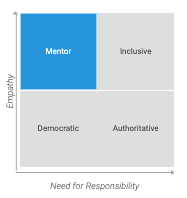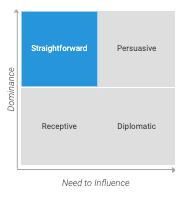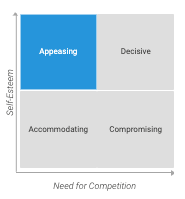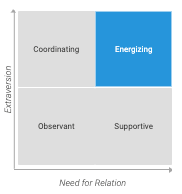Behaviors Uncovered: Leadership, Communication, Conflict Management and Team Contribution
How can employers understand how someone will behave in a professional context? Do organizations have to rely on a trial-and-error approach to hiring and management, or is there a way to make better informed decisions based on science?
Thankfully, years of behavioral modeling have left a strong legacy in various fields of psychological research, from social psychology to behavioral economics. Using the progress in this area as a knowledge base, we were able to combine two key areas of results from our MyPrint® questionnaire — personality and motivational traits — to uncover the likely behaviors of individuals in professional settings.
From Personality and Motivations to Behaviors
MyPrint reports consist of three main areas of focus: Personality, Motivations and Behaviors:
- Personality traits correspond to the attitudinal & emotional characteristics underlying people’s stable behaviors.
- Motivations correspond to the desires and needs triggering, orienting and maintaining an individual’s behaviors towards a given objective.
- Behaviors represent the ranges of observable actions made by individuals in conjunction with their environment.
The 11 behavioral dimensions of MyPrint are displayed as score matrices resulting from the combination of personality and motivation dimensions of the assessment. Therefore, the behavioral styles of MyPrint are predicted based on the scores (high or low) that an individual has obtained on the personality and motivation dimensions crossed together. In short, these analytical grids give insights for understanding why an individual tends to foster a particular pattern of actions and how they maintain it.
As we uncover the science behind predicting behaviors in the workplace, we begin with four key dimensions for employers focusing on better understanding group dynamics within their teams: Leadership Style, Communication Style, Conflict Management and Team Contribution.
Leadership Style
Leadership Style can be described as the way that a person motivates their peers to contribute to the effectiveness of their organization. This applies to individuals formal leadership positions, information leadership positions, or people who might not appear to have any leadership roles at all. Anyone can influence their peers and impact their organization.
There are four styles of leadership, derived from the combination of the “Empathy” dimension of personality and the “Need for Responsibility” dimension of motivation:
- Mentor (Empathetic, Need for Sharing Responsibility): Individuals who are Mentor Leaders build emotional bonds by empowering others and offering plenty of positive feedback.
- Inclusive (Empathetic, Need for Taking Personal Responsibility): Individuals who are Inclusive Leaders drive necessary changes by mobilizing everyone toward a common vision.
- Democratic (Individualistic, Need for Sharing Responsibility): Individuals who are Democratic Leaders guard themselves against backlash by letting others give their inputs upstream.
- Authoritative (Individualistic, Need for Taking Personal Responsibility): Individuals who are Authoritative Leaders tend to demand compliance since they would take full responsibility for issues that may arise.
Communication Style
Communication Style can be summarized as the way that a person sends a message to one or many peers, verbally or otherwise. For employees, there’s an ever-growing number of ways to communicate beyond just face-to-face interaction. Understanding the way an individual tends to express their thoughts and opinions during in-person conversations, emails, video calls and more can help predict their future interactions in the workplace.
There are four styles of communication, derived from the combination of the “Dominance” dimension of personality and the “Need to Influence” dimension of motivation:
- Straightforward (Assertive, Need to Open Up to Others’ Opinions): Individuals who are Straightforward Communicators are inclined to clearly state their ideas while keeping a neutral tone and being respectful of others’ views.
- Persuasive (Assertive, Need to Sway Others’ Opinions): Individuals who are Persuasive Communicators are inclined to dominate others in interactions by openly convincing them to see things their way.
- Receptive (Compliant, Need to Open Up to Others’ Opinions): Individuals who are Receptive Communicators are inclined to speak softly in interactions, and mostly listen to others’ points of views in order to please them.
- Diplomatic (Compliant, Need to Sway Others’ Opinions): Individuals who are Diplomatic Communicators are inclined to control the course of discussions to their advantage by placing underlying messages in their spoken words.
Conflict Management
Conflict Management can be described as the way that a person tries to limit the negative aspects of a confrontation while increasing its positive impacts. Conflict doesn’t always take place in the form of direct confrontation. Being aware of the ways in which individuals will handle situations where there are differing opinions — both big and small — can help leaders facilitate as needed so that certain individuals’ voices and opinions are being heard over the individuals who might be more confident and determined to win.
There are four behavior types when it comes to conflict management, derived from the combination of the “Self-Esteem” dimension of personality and the “Need for Competition” dimension of motivation:
- Appeasing (Confident, Need to Cooperate): Individuals who are Appeasing in Conflict tend to dig into the underlying concerns and consider the views of others.
- Decisive (Confident, Need to Win): Individuals who are Decisive in Conflict tend to settle it by asserting their own solution.
- Accommodating (Modest, Need to Cooperate): Individuals who are Accommodating in Conflict put aside their own needs in order to keep the peace with others.
- Compromising (Modest, Need to Win): Individuals who are Compromising in Conflict tend to ignore or withdraw from it rather than facing it.
Team Contribution
Team Contribution can be summarized as the way that an individual cooperates and works with others in a group setting in order to achieve organizational goals. This is not only useful for individuals who work in the same department or formal team, but for understanding the role a person tends to play even in the informal group projects and activities that occur in the workplace.
There are four ways individuals can approach team contribution, derived from the combination of the “Extraversion” dimension of personality and the “Need for Relation” dimension of motivation:
- Coordinating (Extroverted, Need for Privacy): Individuals who are Coordinating teammates expect efficiency, focus on goals and coordinate people together
- Energizing (Extroverted, Need to Socialize): Individuals who are Energizing teammates get excited and draw others in with enthusiasm, while showing a relatively short attention span.
- Observant (Introverted, Need for Privacy): Individuals who are Observant teammates focus on content, and are likely to ask others about their expectations regarding their role in the process.
- Supportive (Introverted, Need for Socialize): Individuals who are Supportive teammates are loyal team players, by actively listening, discussing and defending the different views of others.
The behaviors results of MyPrint help in understanding the ways in which individuals actually act or conduct themselves, especially toward others. This knowledge can be invaluable in building a more productive workplace.
In our next entry in our three-part Behaviors Uncovered series, we investigate three areas that are critical to the development of highly-effective problem solving teams — creativity, work and learning styles.
Interested in uncovering more about how behavior profiles can help you understand how someone will act in a professional setting? Discover the science behind MyPrint by clicking here.




